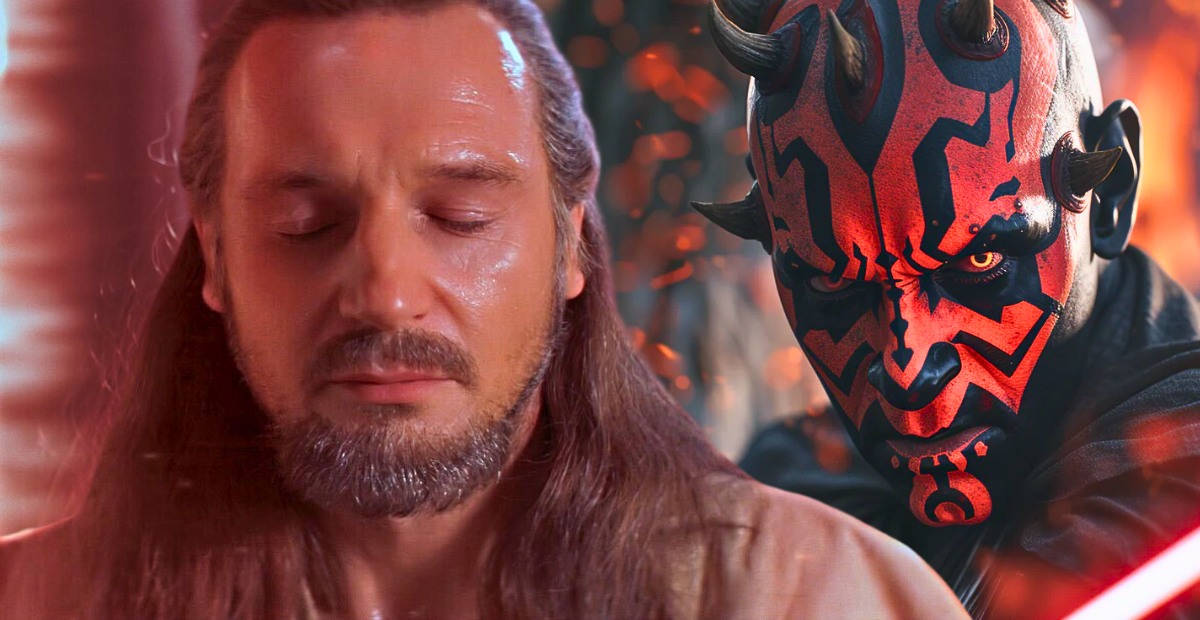I never really understood why Qui-Gon sat down to meditate during his duel with Darth Maul in The Phantom Menace. At first glance, it almost felt out of place—why pause in the middle of such a life-or-death battle? But after playing Star Wars: The Old Republic and seeing how Jedi and Sith recover their strength in completely opposite ways, that moment finally clicked for me. It turned out what looked like a strange pause was Qui-Gon recharging, centering himself through calm.
The Calm vs. The Storm
What I love most is how this scene delivers the personalities of the characters without saying a word.
There’s a part in the script that says, “QUI-GON is in a split second fighting the DARK LORD with a ferocity not seen before.”
That line captures the immediate shift in energy once those gates open. Qui-Gon, who was meditating just a moment before, suddenly becomes this fierce force in combat.
It’s like his meditation charged him up, and he’s able to unleash this pent-up energy as soon as the opportunity arises.
On the other side, the script describes Maul as pacing menacingly, like a predator.
That pacing isn’t just for show – it’s Maul drawing on his rage and hatred, keeping himself in a heightened state of aggression.
While Qui-Gon gets his strength from inner calm, Maul powers up through his anger, staying restless and ready to strike.
Obi-Wan, on the other hand, is a mix of both. He’s pacing a bit, clearly anxious, but he’s not as frantic as Maul.
He’s younger, less experienced than Qui-Gon, and still a bit impulsive. It’s a perfect little moment that visually captures where each of them is on their journey.
Jedi Meditation vs. Sith “Seethe” In Star Wars: The Old Republic
Here’s where it gets interesting. In Star Wars: The Old Republic game, there are abilities like “Introspection” for Jedi and “Seethe” for Sith.
Both moves allow characters to recover their energy, but they do it in completely different ways – Jedi by focusing on peace and the Sith by focusing on hate.
Now, I know the game isn’t canon, but the concept fits so well here. Qui-Gon’s meditation feels like a direct inspiration for “Introspection,” while Maul’s pacing is a perfect match for “Seethe.”
One is centered and peaceful, while the other is fiery and filled with hatred.
I always thought it was a cool detail that Qui-Gon and Maul are essentially doing their own forms of meditation here.
Qui-Gon is aligning himself with the Force, focusing on the moment, while Maul is drawing on his inner rage.
It’s like they’re both “recharging,” but in completely opposite ways. Maul is the type of guy who’d channel his frustration and rage into power – totally fitting for a Sith.
The Missed Opportunity with Force Speed
Now, a lot of people wonder why Obi-Wan didn’t use Force Speed to catch up to Qui-Gon when the gates closed.
It’s funny because Force Speed was actually shown earlier in the movie, so you’d think he’d use it again here, right?
My take? Obi-Wan’s impatience and anxiety might’ve clouded his mind, making it hard for him to tap into that ability.
If he had taken a page from Qui-Gon’s book and meditated for even a couple of seconds, he might’ve been able to center himself enough to reach his master.
Instead, he’s pacing, visibly anxious and not really in the right headspace to use Force Speed.
It’s like he’s learning – maybe the hard way – about the value of patience and focus, lessons he would later try to pass on to Anakin.
In a way, it feels like Obi-Wan’s failure here is what pushes him to become the wise, calm Jedi Master we see later.
Why Qui-Gon Didn’t Retreat to Obi-Wan
When you look at that final showdown between Qui-Gon and Maul, it’s easy to wonder why Qui-Gon didn’t just fall back towards Obi-Wan for a more coordinated attack.
It’s tempting to think retreating might have saved him, but that wouldn’t align with Qui-Gon’s style or the reality of the situation.
Qui-Gon was using the Ataru form, a highly aggressive lightsaber style focused on overwhelming the opponent quickly.
With this form, retreating isn’t ideal – it’s all about pressing forward and keeping the enemy on the defensive.
Backing off would’ve allowed Maul to regroup and go on the attack himself, something Qui-Gon couldn’t afford in such a confined space.
Another big factor? Protecting Obi-Wan. At that moment, Obi-Wan had been separated by the energy gates, and pulling Maul towards him would’ve put his Padawan at even greater risk.
Qui-Gon likely felt that he had a better chance taking on Maul alone, where he could focus solely on the duel without worrying about Obi-Wan’s safety.
And then there’s Qui-Gon’s connection to the Force. Right before the final clash, we see him pause to meditate. For Qui-Gon, trusting in the Living Force is key.
He might’ve sensed that this was his moment, that confronting Maul head-on was necessary, even if it meant risking his life.
For a deeper look into why he made this choice, you may want to check out the full breakdown here.

